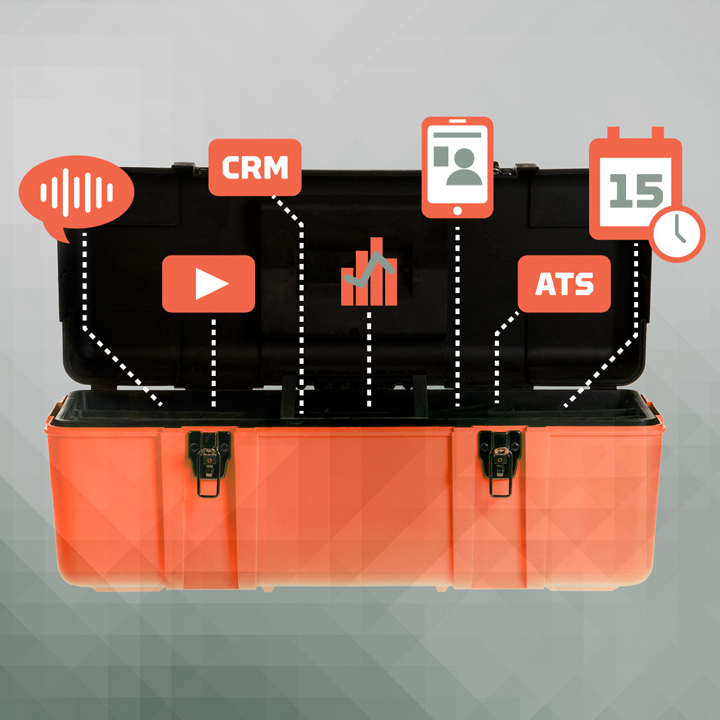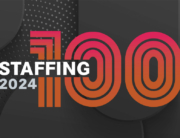The right applications make any staffing task easier
In fact, there are so many add-ons, off-the-shelf software programs and mobile apps to choose from, selecting and implement ones that fit your needs, budget and processes can be the biggest challenge.
“There is no one best tool,” said J.P. Medved, content marketing director for Capterra Inc. “Keep your best practices in mind, do your research and look for a solution that aligns with your current processes.”
Having access to a well-stocked technical toolkit puts the solution to any challenge at your team’s fingertips. And today’s vast offerings make it easy to add features and functionality to an existing technical platform.
Here’s a sampling of tools that are worthy of a spot in your technical toolbox.
[Editor’s note: The examples of products listed in this feature are for informational proposes only and are not all-inclusive. This is not an endorsement by Staffing Industry Analysts.]
Tools for Service Teams
Onboarding Platforms
Are you still faxing forms to new hires? Or ushering workers into the conference room to watch safety videos? Onboarding contingent workers for disparate clients and worksites can be paper-intensive and error-prone.
Web-based onboarding systems distribute forms, handbooks and other materials electronically. Popular options include candidate portals that integrate with existing websites, e-signatures, online progress tracking and automated reminders. Entice candidates by letting them watch orientation videos or complete paperwork on their mobile devices. And if you want to extend your firm’s global reach, choose a platform that supports multiple languages.
Examples: iCIMS Onboard, Applicant-Stack, Initiafy and LearnUpon
Reference Checkers
Completing reference checks can improve quality of hire and decrease refunds and falloffs. But phone calls to previous supervisors often go unreturned and snail mailing forms is a waste of time and a postage stamp.
Automated reference checking tools use a brief online survey to collect performance feedback from past employers and service providers boast impressive return rates of nearly 80%. If you need to verify a candidate’s education, professional licenses and credentials, there’s a service for that as well. In addition, some tools marry references with pre-hire assessments and other data to predict on-the-job success.
Examples: ChequedReference, Pre-Hire 360 and Checkster’s Reference Checkup
Scheduling Tools
Filling last-minute assignments and communicating shift changes to large groups of contingent workers can be time consuming and stressful. Online scheduling tools let nurses, substitute teachers, production workers and event personnel update their availability and accept assignments via the Web or mobile devices.
Agency staff can post open assignments and communicate shift changes with the click of a mouse. Popular options include texting, calendar integration, reporting and timekeeping. Providers usually offer multiple versions, so you can choose a tool designed for contingent staffing or shiftwork in a particular niche or industry.
“Always look for an intuitive user interface anytime you select a tool that will be used by applicants or employees,” notes Katherine Jones, VP, HCM Technology Research for Bersin by Deloitte.
“Tools should not only enhance productivity, they should help you attract and retain people.”
Examples: NimbleSchedule, Quick-Staff, ShiftBoard and Peoplenet
Text and Voice Messaging
Do you need a way to contact candidates located outside the US? Are staff members dropping calls and missing text messages due to poor cell phone reception in your office?
“Use a short message service (SMS) to start a conversation with a candidate,” suggests Ward Christman, chief advisor for HRTech Advisor. “SMS lets you text someone from a landline or desktop computer and some platforms work with as many as 800 mobile carriers throughout the world.”
Examples: TextRecruit, Google Voice, Loop and TextNow
Other helpful tools for service teams include: employee performance trackers, engagement and recognition platforms, evaluation and testing, pulse surveys, time and attendance, and email integrators.
Tools for Recruiters
ATS + CRM
Applicant tracking systems (ATS) certainly aren’t new. In fact, some 75% of staffing firms already use an ATS according to Medved. Despite their popularity, the primary purpose of an ATS is to register applicants. They’re not designed to track the movement of passive candidates, engage them or manage talent pipelines.
At last, traditional software providers are beginning to integrate client relationship management (CRM) functionality into their ATS and many online ATS already offer CRM functionality. Now, instead of using a spreadsheet to track prospective candidates and recruiting activity, recruiters can navigate the entire process from a centralized hub. Some programs even facilitate communications with passive candidates or let recruiters delegate tasks and share resumes with teammates.
Examples: Bullhorn, Jobscience Salesforce, ZohoCRM, Nimble, Big Biller and iCIMS
Pipeline Trackers
If you don’t want to migrate to a new ATS, there are any number of mobile apps or online tools that can help your recruiting team attract candidates, execute activities and manage their pipelines. Mobile apps use tagging systems to indicate a candidate’s skills, location or level of engagement and visualize pipelines. And some help recruiters manage their to-do lists by sending follow-up reminders to their cell phones or email.
Examples: Pipedrive, Highrise, Streak
Browser Extenders and Web Scrapers
Candidates frequently post their résumés and profiles on multiple job boards and sites. Combing through duplicates can be frustrating and updating candidate records can be time consuming.
Browser extenders or Web scrapers streamline Web sourcing by parsing resumes, aggregating candidate data and creating a bridge between job boards and ATS.
“Extenders provide a pop-up window so you don’t have to log into the database to add notes or initiate contact with candidates,” Christman says. “And some grab résumés from the Internet and drop them into your ATS or update existing records. Best of all, most browser add-ons are free.”
Some tools embolden the matching process by using an algorithm to rank the alignment between a candidate’s experience and a job requisition. Others create complex Boolean search strings that produce more precise results than traditional keyword searches.
Examples: Colleague Add-On for IE, Entelo Button, Falcon, Nimble and Ring-Lead Profiler
Labor Market Analyzers
Tired of fishing for candidates in the wrong pool? These handy tools provide real-time labor market supply and demand data including wages, job openings, turnover, staffing and commuting patterns, workers’ comp claims and EEO statistics. They can profile the population of a particular geography including education levels, certifications and so forth. And they can even tell you which industries are growing in a particular area.
Examples: Americas Labor Market Analyzer (ALMA), Burning Glass, JOLTS, LEHD (Census Bureau), Staffing Industry Analysts
Digital Interviews
If coordinating interviews across time zones is curtailing placements and global expansion, let candidates record their answers to emailed questions via webcam. Digital interviews enable facetoface live or recorded meetings with busy candidates or out-of-town job seekers.
Recruiters can play back, pause or share a candidate’s answers with colleagues or clients at their leisure. And, if you want to conduct video interviews on your smartphone or tablet there’s a tool for that as well. Some tools give clients and recruiters the opportunity to record a short promotional video. Combining personal outreach with technology may give you an edge with technically savvy candidates.
Examples: HireVue, Recruitby, Jobvite and VidCruiter
Tools for Sales and Marketing Teams
Lead Generators
Generating leads and improving lead quality were rated as the biggest challenges faced by B2B marketers according to a recent survey. To solve those problems, lead providers have developed new tools that mine data from multiple sources and analytics that help to identify the ideal prospects for your services. They’re even tracking prospects’ online activity to pinpoint the ideal time to engage them.
For instance, most lead services review SIC codes, credit ratings, headcount, sales volume and so forth but now they’re also looking at company websites, press releases, news and social media activity. Considering a generator’s methodology can help you procure targeted leads that match your staffing specialty and sales objectives.
For instance, Kathryn Mujezinovic, VP of business development and digital marketing for Link Staffing, uses a service to provide leads to franchisees entering new markets, and another to help veteran franchisees penetrate existing markets.
Examples: Salesgenie and Data.com
Sales Team Automation
Although most staffing firms collect customer and prospect information, a generic database isn’t designed to plot sales cycles, manage pipelines, track opportunities or forecast revenue.
Automating the sales function can help you manage individuals and distributed teams and extend your sales efforts to a larger base of prospects. Popular options for sales-oriented CRMs include email marketing and campaign management, commission management, sales forecasting and pipeline visualization. By the way, software-as-a-service (SaaS) deployments currently account for 50% of the CRM market and are projected to reach 80% to 85% by 2025 according to Gartner analysts.
Examples: Salesforce, Agiloft, On Demand CRM
Marketing Automation
Combining marketing and sales automation can create a one-two punch of recurring revenue. In fact, some marketing tools feature native integration with popular sales CRMs.
Most online marketing systems let you design and execute complex, multi-level campaigns, segment and analyze customers, manage webinars and events, place ads and track ROI, track website traffic and more. Automated marketing may be too complex for some sales staff, but it can be a powerful tool in the hands of a dedicated, experienced marketing professional.
Examples: Marketo, Oracle Marketing Cloud and Pardot







